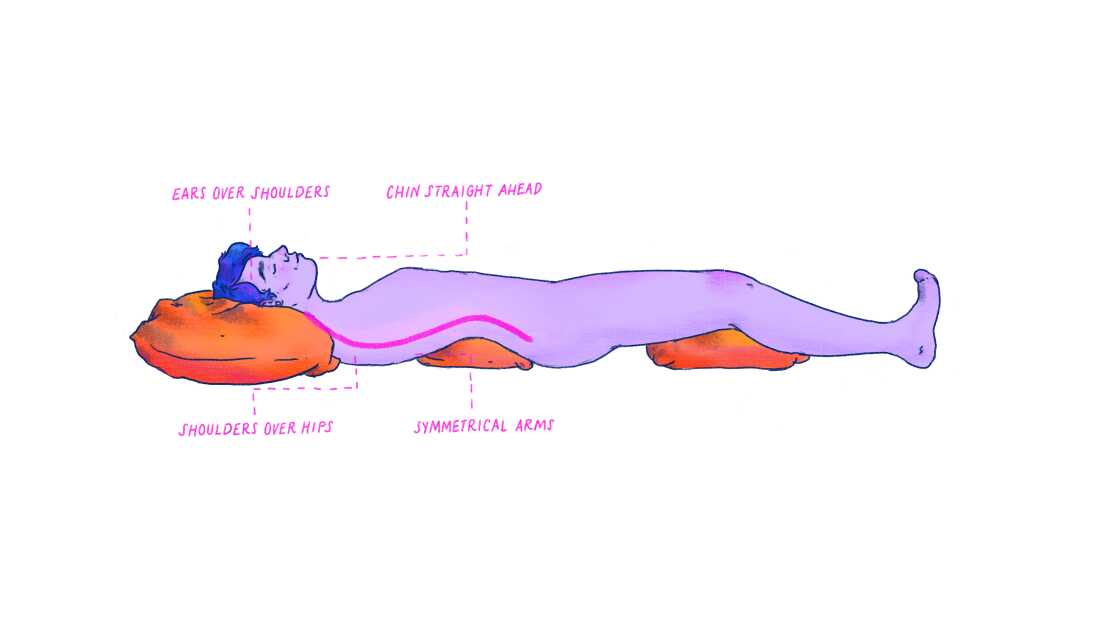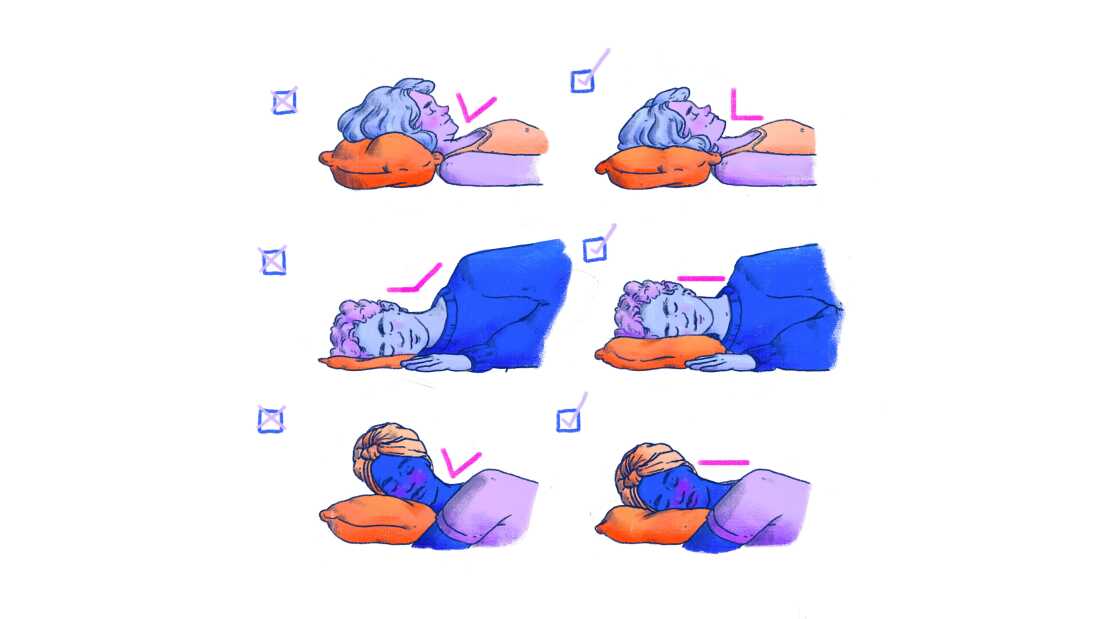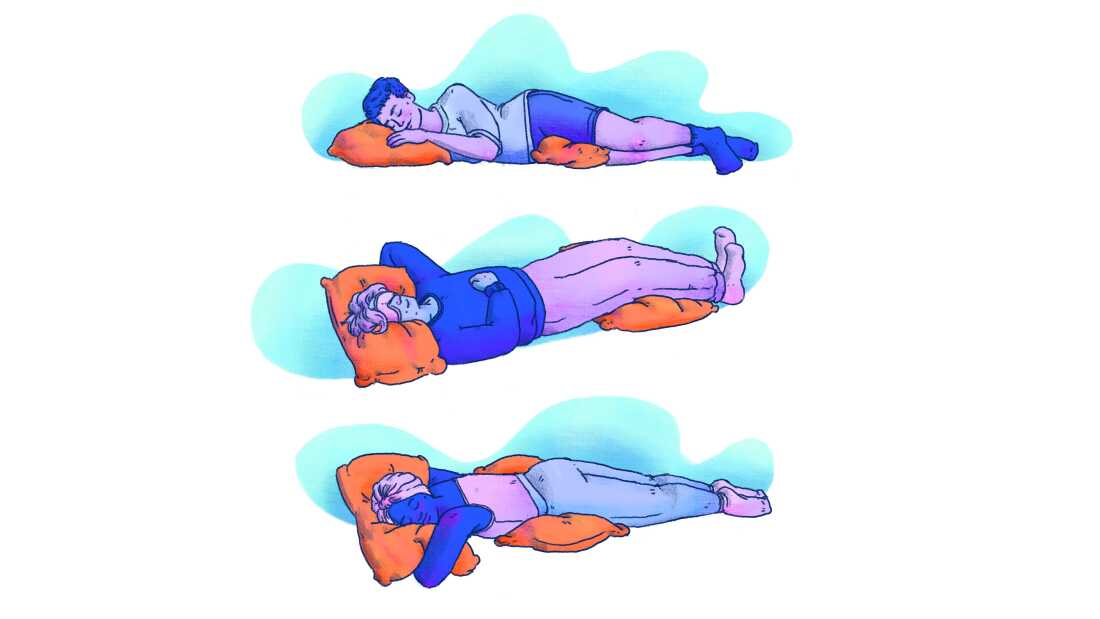Spending the night in an uncomfortable position can lead to stiffness and soreness in the morning. Experts recommend paying close attention to how you position yourself during sleep to prevent these aches.
Meredith Miotke for NPR
toggle caption
Meredith Miotke for NPR
Have you ever woken up with a nagging ache in your lower back or shoulders that lingers throughout the day? Or found your neck so stiff in the morning that turning to look outside feels impossible?
These common morning discomforts often stem from inadequate support during sleep, explains Ellen Wermter, a nurse practitioner at Restorative Sleep Medicine in Virginia. One straightforward way to reduce such pain is by improving your sleeping posture, according to health professionals.
When you sleep in a position that leaves gaps between your body and your pillow or mattress, your muscles compensate by tightening to protect soft tissues, Wermter notes. This tension can build up overnight, causing inflammation and soreness, as well as restless sleep from frequent position changes.
Regardless of whether you prefer sleeping on your back, side, or stomach, here are expert-backed tips to help you wake up feeling refreshed and pain-free.
Align Your Sleep Posture with Your Natural Standing Position

Sleeping in a posture that mirrors your standing alignment helps prevent muscle strain, says Ellen Wermter. This illustration highlights how to maintain the natural curve of your spine while resting.
Meredith Miotke for NPR
toggle caption
Meredith Miotke for NPR
The key to avoiding morning neck and back pain is to maintain a sleeping position that supports the natural curvature of your spine, Wermter advises. Your body should form a straight line from the crown of your head down to your tailbone.
Specifically, position your ears directly above your shoulders, and your shoulders aligned over your hips. Keep your chin level, neither tucked toward your chest nor tilted upward. Aim for balanced arm placement to encourage healthy circulation.
Back sleepers will find this posture easier to adopt, but side and stomach sleepers might need to adjust their bedding or gradually train themselves to sleep this way for better spinal alignment.
Limit Sleeping on Your Stomach
Although lying on your stomach can help open airways for those who snore, it often leads to neck, back, and shoulder discomfort, Wermter warns. This position frequently causes the neck to twist unnaturally, disrupting spinal alignment and leading to restless nights.
Select a Pillow That Supports Your Head Properly

Pillow height, or loft, plays a crucial role in preserving correct sleep posture and preventing neck discomfort. The left side shows unsuitable pillow heights for different sleep positions, while the right side demonstrates the ideal loft for spinal neutrality.
Meredith Miotke for NPR
toggle caption
Meredith Miotke for NPR
Dr. Fabian Morales, a sports medicine specialist, emphasizes the importance of choosing a pillow that supports your neck’s natural curve to enhance sleep quality and reduce pain.
For back sleepers: Morales recommends a pillow with moderate firmness and height, or one designed ergonomically to cradle the neck, easing pressure and maintaining alignment.
For side sleepers: Wermter advises measuring the distance from your neck’s bend to your shoulder’s edge to find a pillow that fills this gap without pushing your head upward.
For stomach sleepers: It’s often best to forgo a pillow to avoid neck strain, but if needed, opt for a thin, low-profile pillow to keep your spine aligned.
Replacing pillows every few years is essential, as worn-out pillows lose their shape and accumulate allergens, which can contribute to discomfort and poor sleep.
Fill in Body Gaps with Additional Support

Pillows can be strategically placed to support correct sleep posture across different sleeping styles.
toggle caption
Proper spinal support is vital to prevent discomfort, Wermter explains. To compensate for any spaces between your body and mattress, use smaller pillows, rolled towels, or blankets to cradle your spine fully-not just your head and neck.
Back sleepers: Pay attention to gaps under your lower back or knees, which can cause lumbar pain. Adding support in these areas can alleviate pressure.
Side sleepers: Many find relief by placing a pillow between their knees or hugging a body pillow to keep hips aligned and reduce strain on the lower back.
Stomach sleepers: While a flat surface is generally sufficient, some may benefit from a thin pillow beneath the hips or abdomen to ease back tension.
Choose a Mattress with Balanced Firmness
Wermter advises evaluating your mattress’s condition and replacing it every seven years or sooner if it no longer provides adequate support. A mattress that’s too soft allows heavier body parts to sink, misaligning the spine, while one that’s too firm can create uncomfortable pressure points.
Explore Additional Methods for Pain Relief
If you’ve optimized your sleep environment but still wake up with aches or stiffness, you’re not alone. Dr. Charla Fischer, an orthopedic spine surgeon at NYU Langone Health, notes that such discomfort is common, especially as the spine ages.
While usually not serious, persistent pain lasting more than a week, or symptoms like numbness, tingling, or weakness in the neck, arms, or hands, warrant medical evaluation.
For typical muscle soreness, over-the-counter anti-inflammatory medications, gentle massage, stretching, and alternating ice or heat packs applied for 20 to 30 minutes can provide relief.
Don’t underestimate the soothing effect of a warm shower, which can relax tight muscles and ease discomfort.
This article was revised by Malaka Gharib with visual editing by Beck Harlan. We welcome your feedback-contact us via voicemail at 202-216-9823 or email LifeKit@npr.org.
Subscribe to Life Kit on Apple Podcasts and Spotify, sign up for our newsletter, and follow us on Instagram @nprlifekit.























